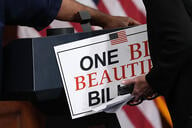You have /5 articles left.
Sign up for a free account or log in.
During the Super Bowl, they air between the soda and the cars and the beer. Animated pandas build a website and Amy Schumer opens a Bud Light, and in the middle of all that, there they are:
“We are one of the largest university systems in the nation.”
“We study the mind while nourishing the soul.”
“Say we've got grit, and we’ll take it as a compliment.”
It’s hard to sell education during the Super Bowl. But year after year, in a television event where flashy skits and irreverent humor trump substance, universities pay to air their ads alongside the world’s biggest brands.
They rarely have an audience comparable to that of Doritos or Coca-Cola. More than 100 million people watch the Super Bowl, and securing ad space can cost millions of dollars. But in local markets, colleges can reach large audiences for much less.
“Super Bowl advertising is immensely symbolic,” said Tim Calkins, marketing professor at Northwestern University and creator of the Super Bowl Advertising Review. “If a college is going on the Super Bowl, it's doing so because it really needs to make a statement.”
Kent State University will run an ad for the first time this year. The commercial, a trimmed-down version of a two-minute video introducing the university’s branding campaign, will air in Cleveland and Erie, Pa., and it will cost a total of $58,500.
President Beverly Warren decided against a national ad, but she hopes the local spot will attract interest nearby. Already, 80 percent of her students come from the region. And if the Super Bowl viewership numbers are anything like last year’s, the 30-second commercial will be seen by more than a million households.
“There are going to be viewers from all walks of life,” Warren said. “We like the breadth of the Super Bowl viewing. We want to reach as many families and as many individuals as we possibly can.”
Super Bowl ads typically try to appeal to as broad an audience as possible. For colleges, which market to targeted audiences throughout the year, designing a 30-second spot that appeals to everyone and that sells education alongside more traditional Super Bowl fare is a new kind of challenge.
“It's not the place where you do tactical marketing aimed at a specific class of incoming students,” Calkins said. “People only go on the Super Bowl if they really want to reach a huge number of people.”
Kent State’s full-length ad begins with a football montage, and eventually becomes a compilation of students doing things: a student approaches a microphone. A student examines an X-ray. A student waters a potted plant.
“Incredible things can happen in a place where you can be anyone or anything,” the narrator says. “Where it’s OK to be an original, and it’s OK to be conventional.”
More often than not, colleges run Super Bowl ads that focus on the feel of the institution: the strong community, the passionate instructors, the sense of possibility. They are uplifting and fast moving; they want to show that their college is a place where students can thrive, whether they enjoy sports or engineering or gardening or fashion design. Kent State’s message, that you can be “anyone or anything” you want to be, could appeal to anyone.
‘We Have Arrived’
Super Bowl ads are expensive to stage and limited in length, but they’re unlike anything else in traditional marketing. They are, as Warren says, “the opportunity to reach a million households in one moment.”
“For most brands -- especially smaller brands -- advertising in the Super Bowl has a little bit of a prestige factor,” said Vassilis Dalakas, marketing professor at California State University at San Marcos and sports marketing expert. “It’s kind of like, ‘We have arrived.’”
Dalakas said universities’ Super Bowl ads can foster pride among students and instructors. And if a university can do that, those students and instructors may be more likely to communicate the message themselves.
The timing also works in the universities’ favor, Calkins said. The Super Bowl airs around the time when prospective students are considering their options and beginning to make decisions about where they want to go.
Even so, only a few universities spend their advertising budgets on the Super Bowl. Temple University ran an ad last year. So did the University of Iowa College of Dentistry. The University of Akron ran local ads for more than 15 years until this year’s game.
“A Super Bowl is a great way to get a particular message out in sort of a one-shot, 30-second vehicle,” said Larry Burns, the University of Akron’s vice president for advancement. “But if you’re really trying to create an ongoing top-of-mind presence, we just feel that continuing, ongoing messaging is a better value for us.”
And even for universities that have the budget, there’s the danger that a Super Bowl ad will do more harm than good.
“Traditionally, university promotions tend to be terribly standard,” Dalakas said. While a university marketing video may have a pleasant vibe, “it doesn’t fit the expectations that viewers have for Super Bowl commercials.”
That puts colleges in a bind: even though it’s the Super Bowl, Dalakas said, universities should stay true to their brand. An ad that feels like a Doritos commercial might fit in better, but it wouldn’t be true to the university’s message.
And unlike major brands, colleges and universities are nonprofits. What if donors question why their alma mater is spending so much money on 30 seconds of local airtime?
“The Super Bowl is so different from any other marketing vehicle,” Calkins said. “Nobody knows what a typical ad costs. Everybody knows that a Super Bowl ad is expensive.”
But at Kent State, the timing was too perfect not to try. The university just unveiled a new marketing campaign, which wasn't planned to coincide with the Super Bowl. And now, all at once, the university is hoping to reach everyone: prospective students, parents, alumni. “We think many of them will be glued to their televisions on Super Bowl Sunday,” Warren said.




